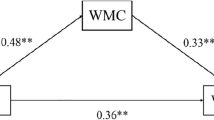Abstract
There is mounting evidence that people with autism have executive function deficits and that those deficits are linked to the social impairment characteristic of autism. Bennetto et al. Child Dev.(1996) 67: 1817–1835 suggest that, more specifically, people with autism may have a deficit in working memory. This hypothesis was tested using a visual perspective-taking task whose working memory load could be systematically varied. The performance of participants with autism on this task was significantly worse than that of the control participants.
Similar content being viewed by others
REFERENCES
American Psychiatric Association (1987). Diagnostic and Statistical Manual of Mental Disorders, American Psychiatric Association, Washington, DC.
Bennetto, L., Pennington, B. F., and Rogers, S. J. (1996). Intact and impaired memory functions in autism. Child Dev. 67: 1816–1835.
Case, R. (1992). The role of the frontal lobes in the regulation of cognitive development. Brain Cognit. 20: 51–73.
Chelune, G. J., Ferguson, W., Koon, R., and Dickey, T. O. (1986). Frontal lobe disinhibition in attention deficit disorder. Child Psychiatry Hum. Dev. 16: 221–234.
Clarke, P., and Rutter, M. (1979). Task difficulty and task performance in autistic children. J. Child Psychol. Psychiatry 20: 271–285.
Dunn, L. M., and Dunn, L. M. (1981). Peabody Picture Vocabulary Test-Revised, American Guidance Service, Circle Pines, MN.
Hobson, R. P. (1984). Early childhood autism and the question of egocentrism. J. Autism Dev. Disord. 14: 85–104.
Hughes, M., and Donaldson, M. (1979). The use of hiding games for studying the coordination of viewpoints. Educ. Rev. 31: 133–140.
Hughes, C., and Russell, J. (1993). Autistic children's difficulty with mental disengagement from an object: Its implications for theories of autism. Dev. Psychol. 29: 498–510.
Llamas, C., and Diamond, A. (1991). Development of Frontal Cortex Abilities in Children Between 3–8 Years of Age, Biennial meeting of the Society for Research in Child Development, Seattle,WA.
Mazzocco, M. M. M., Hagerman, R. J., Cronister-Silverman, A., and Pennington, B. F. (1992). Specific frontal lobe deficits among women with the fragile X gene. J. Acad. Child Adolesc. Psychiatry 31: 1141–1148.
Mazzocco, M.M. M., Pennington, B. F., and Hagerman, R. J. (1993). The neurocognitive phenotype of female carriers of fragile X: Further evidence for specificity. J. Dev. Behav. Pediatr. 14: 328–335.
McEvoy, R. E., Rogers, S. J., and Pennington, B. F. (1993). Executive function and social communication deficits in young autistic children. J. Child Psychol. Psychiatry 34: 563–578.
Mesibov, G. B., Schopler, E., Schaffer, M. A., and Michal, N. (1989). Use of the childhood autism rating scale with autistic adolescents and adults. J. Acad. Child Adolesc. Psychiatry 28: 538–541.
Moffitt, T. E., and Henry, B. (1989). Neuropsychological assessment of executive functions in self-reported delinquents. Dev. Psychopathol. 1: 105–118.
Ozonoff, S., Pennington, B. F., and Rogers, S. J. (1991a). Executive function deficits in high-functioning autistic individuals: Relationship to theory of mind. J. Child Psychol. Psychiatry 32: 1081–1105.
Ozonoff, S., Rogers, S. J., and Pennington, B. F. (1991b). Asperger's syndrome: Evidence of an empirical distinction from high-functioning autism. J. Child Psychol. Psychiatry 32: 1107–1122.
Ozonoff, S., Strayer, D. L., McMahon, W. M., and Filloux, F. (1994). Executive function abilities in autism and Tourette Syndrome: An information processing approach. J. Child Psychol. Psychiatry 35: 1015–1032.
Pennington, B. F., Groisser, D., and Welsh, M. C. (1993). Contrasting cognitive deficits inattention deficit hyperactivity disorder versus reading disability. Dev. Psychol. 29: 511–523.
Prior, M., and Hoffmann, W. (1990). Brief report: Neuropsychological testing of autistic children through an exploration with frontal lobe tests. J. Autism Dev. Disord. 20: 581–590.
Reed,T. (1994). Performance of autistic and control subjects on three cognitive perspective taking tasks. J. Autism Dev. Disord. 24: 53–66.
Reed, T., and Peterson, C. (1990). Acomparative study of autistic subjects' performance at two levels of visual and cognitive perspective taking. J. Autism Dev. Disord. 20: 555–567.
Rumsey, J. M. (1985). Conceptual problem solving in highly verbal, nonretarded autistic men. J. Autism Dev. Disord. 15: 23–35.
Rumsey, J. M., and Hamburger, S. D. (1988). Neuropsychological findings in high functioning autistic men with infantile autism, residual state. J. Clin. Exp. Neuropsychol. 10: 201–221.
Rumsey, J. M., and Hamburger, S. D. (1990). Neuropsychological divergence of high-level autism and severe dyslexia. J. Autism Dev. Disord. 20: 155–168.
Russell, J., Jarrold, C., and Hood, B. (1999). Two intact executive capacities in children with autism: Implications for the core executive dysfunctions in the disorder.J. Autism Dev. Disord. 29: 103–112.
Russell, J., Mauthner, N., Sharpe, S., and Tidswell, T. (1991). The ‘windows task’ as a measure of strategic deception in preschoolers and autistic subjects. Br. J. Dev. Psychol. 9: 331–349.
Schopler, E., Reichler, R. J., and Renner, B. R. (1990). The Childhood Autism Rating Scale, Western Psychological Services, CA.
Shallice, T., and Burgess, P. (1991). Higher-order cognitive impairments and frontal lobe lesions in man. In Levin, Eisenberg, and Benton (eds.), Frontal Lobe Function and Dysfunction, Oxford University Press, New York.
Sobesky, W. E., Pennington, B. F., Porter, D., Hull, C. E., and Hagerman, R. J. (1994). Emotional and neurocognitive deficits in fragile X. Am. J. Med. Genet. 51: 1–8.
Stuss, D. T., and Benson, D. F. (1986). Executive system. In Stuss, D. T., and Benson, D. F. (eds.), The Frontal Lobes, Raven Press, New York.
Author information
Authors and Affiliations
Corresponding author
Rights and permissions
About this article
Cite this article
Reed, T. Visual Perspective Taking as a Measure of Working Memory in Participants With Autism. Journal of Developmental and Physical Disabilities 14, 63–76 (2002). https://doi.org/10.1023/A:1013515829985
Issue Date:
DOI: https://doi.org/10.1023/A:1013515829985




